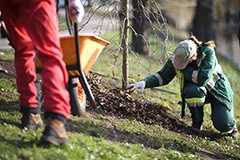Select a location where site conditions are conducive to the specific species of tree being planted. Make sure enough space is available for the mature size of it. It should be in a place that has the proper sunlight needed for the tree. Most trees, such as oaks, maples, and pines, require full sun. Others, such as the common dogwood, need part shade to grow. Ensure the soil drains appropriately. Some trees, such as willows, river birches, bald cypresses, and red maples, can tolerate wet soils. Also, use trees that can handle our climate. Our weather is too hot for spruces, firs, ornamental cherries, and white pines. On the contrary, our winters are too harsh for most palm trees and any citrus.
Once the planting location has been determined, dig a hole that is two to three times the rootball’s width and no deeper than the top of it. If the roots are pot-bound, use a knife or razor and make several cuts on the rootball side to loosen them. Once it is set in the hole, its upper surface should be level with the existing soil. Afterward, cut and remove the rope, twine, or wires holding the burlap in place and circling the trunk on balled and burlapped trees. Position the tree with the main stem straight up.
The next step is to backfill the hole with the soil that has been dugout. Avoid using organic soil amendments since they can interfere with root growth and water movement.
Fill around the roots and gently pack the soil to prevent the formation of air pockets. Rake the soil evenly over the entire area, and cover it with two to four inches of a fine-textured organic mulch such as pine straw, pine bark, cypress bark, or another similar material.
Sometimes mounding the soil at the planting ring’s outer edge to form a water-holding berm is done. The berm will help hold water, but it may also encourage the root growth to remain within it, close to the tree. The American Forestry Association does not recommend berms. Mulch alone should hold the water well enough.
It is best not to stake the tree, but if the wind is a problem or starts to lean, support it with a flexible stake so the trunk will sway in the wind. Movement is necessary for building the trunk’s strength. Remove the stake and wire after one year since leaving wire around the tree can kill it by girdling the trunk.
Do not wrap the trunk with a tree wrap. It will slow the tree’s ability to adapt to the site and provide a favorable environment for insects. The wrap is often held in place with ties at the top and bottom, strangling a tree just as the wire will. The tree needs air and sunlight to develop a healthy, protective bark.
Though planting trees may be somewhat involved, doing so correctly will ensure that they thrive in the home landscape.
The 2021 Annual UGA Extension Gwinnett Plant Sale is underway. We are offering numerous ornamental plants and fruit trees this year. To download an order form, go to the Extension website at www.ugaextension.org/gwinnett<http://www.ugaextension.org/gwinnett>. Or you can contact the Extension office and have it mailed to you.
Timothy Daly is an Agricultural and Natural resource Agent with the University of Georgia Extension Gwinnett County. He can be reached at 678-377-4011 or tdaly@uga.edu.


